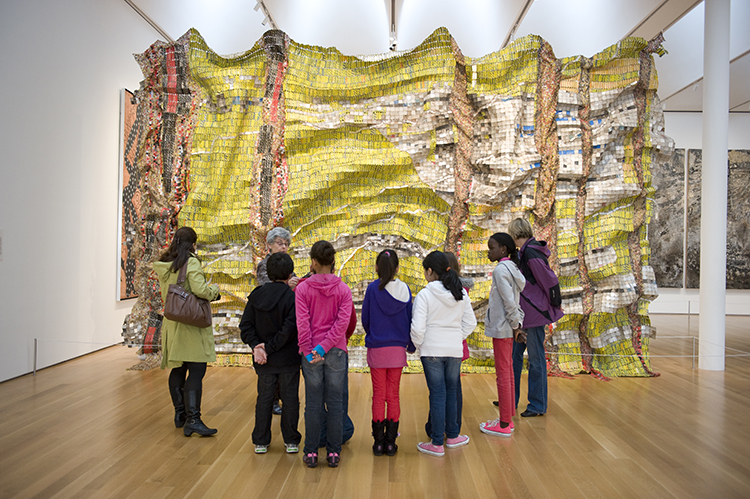Poems that Link Humanity (Quick Tip)
Poems that Link Humanity
By Katherine White, Deputy Director
Poems That Link Humanity
El Anatsui’s Lines That Link Humanity (2008) was commissioned by the North Carolina Museum of Art to honor the opening of its West Building in 2010. It now hangs in East Building’s African Gallery.
Lines That Link Humanity is made largely of bottle caps and liquor packaging— ordinary, discarded objects transformed by the artist’s hand. A quick look draws you to the sculpture’s bright colors and tapestry-like appearance, which veil a deeper meaning when we consider the historical, social, and economic challenges of West Africa, where liquor was once traded for slaves on an international scale. Still, Anatsui’s repurposing and connection of these materials emphasizes human interconnectedness across continents and generations.
Much like Anatsui offers new meaning to common materials, poets across space and time offer new meaning to humble objects, emotions, and experiences. While many of these universal concepts underscore the hardships and challenges of the human condition, they also offer a sense of connection and interconnection, reminding us that we are not alone.
These paired poems by seven different poets share themes with El Anatsui’s Lines That Link Humanity.
- Maya Angelou: “Still I Rise” and “Caged Bird”
- Kofi Awoonor : “Across a New Dawn” and “The First Circle”
- Robert Frost: “Reluctance” and “The Road Not Taken”
- Langston Hughes: “Harlem” and “Mother to Son”
- Pablo Neruda: “Ode to My Socks” and “Your Laughter”
- Wole Soyinka: “In the Small Hours” and “Night”
At Home
We invite you to explore common objects, emotions, and experiences inspired by Lines That Link Humanity, other favorites from our NCMA collection, or your own life. Share your poems on social media and tag #ncartmuseum.
For this exploration we encourage you to use the ode, the Elizabethan sonnet, or free verse.
Odes are lyrical poems meant to be sung and offering praise. Odes come in three different forms and are imaginative, yet formal, and full of sincerity and elaborate language. The irregular ode uses rhyme but does not conform to other rules. Take a second look at Pablo Neruda’s “Ode to My Socks” for one example and at “Ode on a Grecian Urn” by John Keats for another.
Elizabethan sonnets are composed of 14 lines. They are structured in four verses: three quatrains, which are verses made up of four lines, and a concluding rhyming couplet, which is a verse made up of two lines. It has a distinct end-rhyme pattern: abab – cdcd – efef – gg. Generally, the poet’s ideas or mood shift in the first line of the third quatrain, and the poet begins to express a slightly different thought on the subject. We recommend Shakespeare’s Sonnet 30, which focuses on the value of relationships and friendship.
Free verse is poetry that does not rhyme or have a regular meter (beat). For an example take a second look at Langston Hughes’s “Mother to Son.”

